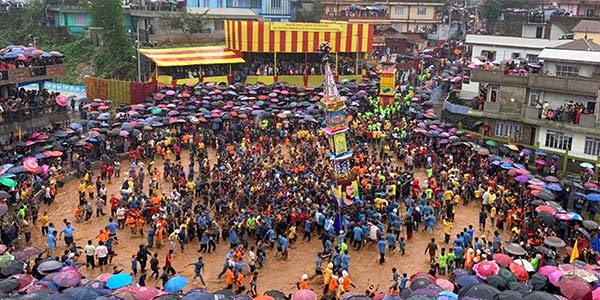Introduction
Behdienkhlam is one of the most significant and vibrant traditional festivals of the Pnar (also known as Jaintia) tribe in Meghalaya. Primarily celebrated in the Jaintia Hills district—especially in Jowai and Tuberkmai—this unique festival is held annually in July, during the monsoon season, just after the sowing of seeds. Deeply rooted in the agrarian way of life and the indigenous Niamtre religion, Behdienkhlam reflects the community’s enduring bond with nature, ancestral spirits, and the age-old cycles of health, disease, and renewal.
Meaning and Significance
The word Behdienkhlam comes from the Pnar language:
- Beh means “to drive away”
- Dien means “wood” or “log”
- Khlam means “plague, pestilence, or disease”
Put together, Behdienkhlam means “driving away the plague.” Historically, the festival evolved as a powerful ritual to protect the community from devastating epidemics such as cholera and smallpox, which once ravaged these hills. Today, it symbolizes a collective cleansing—banishing evil, misfortune, and disease—while invoking blessings for good health, prosperity, and a bountiful harvest.
Unlike many other hill tribes of Northeast India, which later embraced Christianity, the Pnar people, who celebrate Behdienkhlam, have steadfastly preserved the ancient Niamtre faith—a belief system centered on ancestor worship, veneration of nature spirits, and the guardianship of clan deities.
Historical Context
Behdienkhlam has been part of the Pnar cultural fabric for centuries. Oral traditions recount that the festival began when the ancestors of the Jaintia kingdom were struck by a deadly epidemic. Seeking relief, they consulted their priests and spiritual elders, who prescribed a series of rituals—striking rooftops and pathways with bamboo sticks and immersing symbolic logs in sacred waters to cleanse the land of evil forces. Over time, these simple rites evolved into an elaborate annual celebration combining ritual purification, communal participation, music, sport, and an affirmation of cultural identity.
Major Rituals and Customs
Ritual Cleansing (Beating the Houses):
Young men armed with long bamboo poles visit each household, striking rooftops, courtyards, and roads to symbolically chase away malevolent spirits and negative energies.
Rots and Khnongs:
Perhaps the most spectacular part of Behdienkhlam is the grand procession of Rots—towering, artistically decorated wooden structures crafted from bamboo and paper, some reaching up to 40 feet in height. These are carried by groups of men through the streets to the sacred pool Aitnar, where they are ceremoniously immersed. Each village or locality constructs its own Rot, often showcasing elaborate and even humorous designs, sometimes themed around social or environmental messages.
Accompanying the Rots are massive tree trunks called Khnongs, which symbolize evil and misfortune to be cast away. These too are carried and immersed in the sacred waters.
Aitnar Ritual:
The heart of the festival lies at Wah Aitnar, the sacred muddy pool where the Rots and Khnongs are submerged. This act represents the final cleansing and the triumph of good over evil. Crowds gather around the Aitnar to witness this dramatic ritual.
Dad-Lawakor (Mud Football):
Adding to the festivities is a lively game of traditional football, played with a wooden ball in the muddy waters of the Aitnar. Competing teams from different localities vie for victory, as it is believed that the winners will be blessed with a better harvest in the coming season.
Cultural Performances and Feasting:
Throughout Behdienkhlam, the air resonates with the sounds of traditional drums, bamboo flutes, and ritual chants. Sacred offerings are made to clan deities like U Mukhai, Mulong, Musniang, and U Tre Kirod. Communal feasting, singing, and spirited dances foster unity and strengthen social ties.
Cultural and Social Relevance Today
Far beyond a mere religious observance, Behdienkhlam is a living testament to the Jaintia people’s cultural pride and community solidarity. In recent times, the festival’s Rots have also become creative platforms for addressing contemporary issues—some are adorned with themes promoting environmental conservation, anti-corruption, and social harmony.
Drawing both domestic and international visitors who are curious about Northeast India’s rich indigenous traditions, Behdienkhlam is now actively promoted by the Meghalaya government as a symbol of the state’s living heritage.
When and Where
When: Every year in July, after the sowing season, during the peak of the monsoon.
Where: Jowai, the headquarters of West Jaintia Hills District, is the main hub, though similar celebrations are held in Tuberkmai and surrounding villages.
Conclusion
Behdienkhlam stands as a remarkable example of how ancient rituals continue to evolve yet stay rooted in tradition. With its dramatic rites of purification, symbolic processions, muddy football matches, and vibrant community gatherings, Behdienkhlam remains one of India’s most distinctive and lesser-known festivals—a powerful reminder of the enduring spirit and cultural richness of the Pnar people.